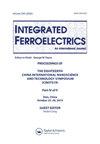Development of Glass for Radiation Shielding Using Material from Perlite in Lopburi Province
IF 0.7
4区 工程技术
Q4 ENGINEERING, ELECTRICAL & ELECTRONIC
引用次数: 0
Abstract
AbstractThis research developed glass material from Perlite. The glasses chemical formula is 20Na2O:40B2O3:(40-X)Perlite:XBi2O3 where X are 0,5,10,15,20, and 25 W% by the melt quenching technique. Physical, optical, its radiation shielding abilities were studied by measuring density, refractive index, transmittance, mass attenuation coefficients, linear attenuation coefficients, and the half value layer (HVL). Densities and refractive indexes of glasses decreased as bismuth oxide (Bi2O3) concentration increased. Transmittance percentage from UV–Visible spectrophotometer showed the highest transmission at 15% concentration of Bi2O3. For radiation shielding properties, the linear attenuation coefficient and the mass attenuation coefficient calculated from WinXCom program showed increasing via added content Bi2O3. The HVL of 5 W% Bi2O3 doped glass is lower than that of concrete. The results of this research show that perlite glass has an ability for radiation shielding material.Keywords: Perliteradiation shieldingBi2O3 AcknowledgmentsThis study would like to express gratitude to Pibulwitthayai School, Thepsatri Rajabhat University, and Nakhon Pathom Rajabhat University for their assistance.Disclosure StatementNo potential conflict of interest was reported by the author(s).华府珍珠岩材料辐射屏蔽玻璃的开发
摘要本研究以珍珠岩为原料开发玻璃材料。通过熔融淬火技术,玻璃的化学配方为20Na2O:40B2O3:(40-X)珍珠岩:XBi2O3,其中X分别为0、5、10、15、20和25w %。通过测量密度、折射率、透过率、质量衰减系数、线性衰减系数和半值层(HVL),研究了其物理、光学、辐射屏蔽能力。随着氧化铋(Bi2O3)浓度的增加,玻璃的密度和折射率降低。紫外-可见分光光度计透射率显示,当Bi2O3浓度为15%时,透射率最高。在辐射屏蔽性能方面,通过WinXCom程序计算得到的线性衰减系数和质量衰减系数均随着Bi2O3的加入而增大。掺5w % Bi2O3玻璃的HVL低于混凝土。研究结果表明,珍珠岩玻璃具有作为辐射屏蔽材料的能力。本研究在此感谢pibulwiththayai学校、Thepsatri Rajabhat大学和Nakhon Pathom Rajabhat大学的帮助。披露声明作者未报告潜在的利益冲突。
本文章由计算机程序翻译,如有差异,请以英文原文为准。
求助全文
约1分钟内获得全文
求助全文
来源期刊

Integrated Ferroelectrics
工程技术-工程:电子与电气
CiteScore
1.40
自引率
0.00%
发文量
179
审稿时长
3 months
期刊介绍:
Integrated Ferroelectrics provides an international, interdisciplinary forum for electronic engineers and physicists as well as process and systems engineers, ceramicists, and chemists who are involved in research, design, development, manufacturing and utilization of integrated ferroelectric devices. Such devices unite ferroelectric films and semiconductor integrated circuit chips. The result is a new family of electronic devices, which combine the unique nonvolatile memory, pyroelectric, piezoelectric, photorefractive, radiation-hard, acoustic and/or dielectric properties of ferroelectric materials with the dynamic memory, logic and/or amplification properties and miniaturization and low-cost advantages of semiconductor i.c. technology.
 求助内容:
求助内容: 应助结果提醒方式:
应助结果提醒方式:


